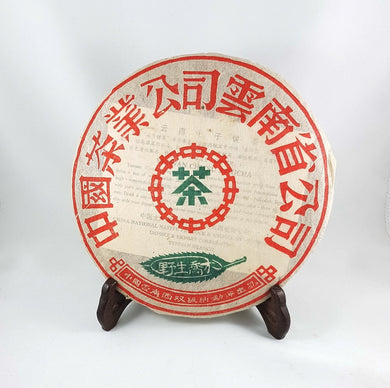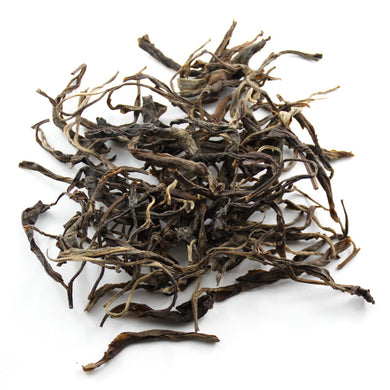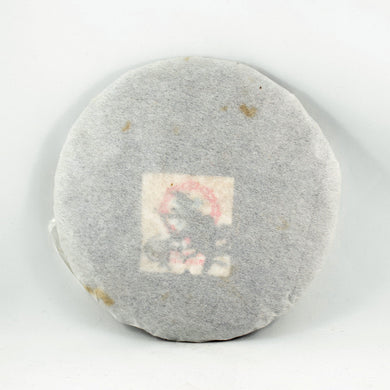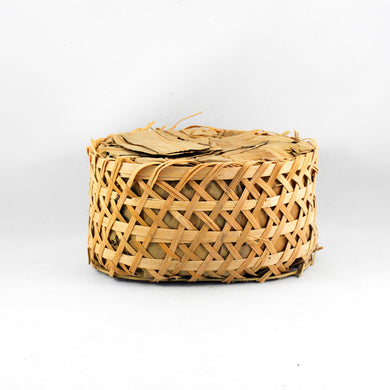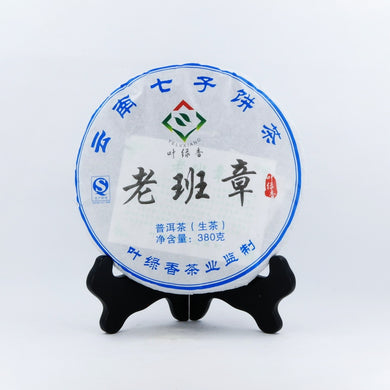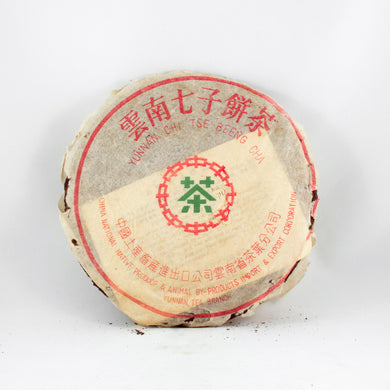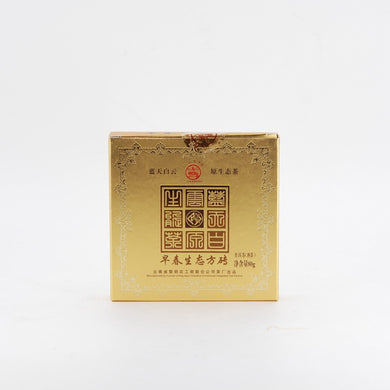2013, 100% Lao Ban Zhang (老班章) Pu-Erh Tea Cake, Collector Edition, (Raw/Sheng)







Leaves
The leaves appear clean, thick and very fresh, Mainly use bigger leaves and blend with some silvery glistening hair, which give rich and strong taste.
Aroma
The aroma is not apparent from a distance, but with closer proximity, one can smell a strong, subtle aroma of orchid fragrance combined with a smooth woody scent which is long lasting and powerful. The aroma brings one to an ancient forest, reminiscent of a flower garden surrounded by old trees of a few hundred years of age.
Soup
Tea soups from different age of Lao Ban Zhang have different colour and thickness. Those older, aged tea possesses a deeper orange colour and more rich with tea oil.
Taste
This Lao Ban Zhang taste rich and powerful. It has some bitterness, but quickly dissipate and the moment the tea travels down the throat, a full, delicious, ice sweet taste emerges and stays for a long time in the mouth. The sensation from the taste is both stimulating and mesmerizing. Even after ten infusions, the tea still taste strong and sweet.
Tea: 2013, 100% Lao Ban Zhang (ѯZ) Pu-Erh Tea Cake, Collector Edition, (Raw/Sheng)
Factory: Ba Da Shan Lao Zai Tea Factory
Weight Per Cake: 320 grams
Origin: Yunnan, Xishuang Banna Region, Bu Lang Mountain, Lao Ban Zhang Village
Types: Sheng/Raw
Harvest Period: 2013
Introduction and History of Lao Ban Zhang
Lao Ban Zhang tea can be traced back to 1476, which originated from the region of Xishuang Banna situated in the province of Yunnan, Menghai County, Bu Lang Mountain, Lao Ban Zhang Village. The old or Lao Ban Zhang village is located apart from the new or Xing Ban Zhang village.
Following are some general statistics of the Lao Ban Zhang village and its surrounding region:
There are a total of 145 families in the Lao Ban Zhang village;
The village resides at an altitude of 1,700 to 1,900 meters; Average temperature of 18.7 oC;
Average 2,088 hours of sun light per year;
Average rain fall between 1,341 to 1,540 mm;
At this high altitude, the village often experience thick fogginess with average annual foggy days between 107.5 to 160.2 days.
There are 4,700 acres of land growing the arbour tree with merely 50 tons of average annual raw tea leaves (green Maocha) production. The original area where Lao Ban Zhang is produced is well preserved with diverse vegetation and culture. The soil is fertile and the area gets abundant sunshine, thick fogs, high humidity, all are optimum conditions for growing ancient trees. Farmers in the Lao Ban Zhang village still use the traditional method to harvest and preserve the ancient tea trees. The leaves are hand picked and no fertilizers and pesticides are used. The leaves are dried under natural sunlight to kill green and are pollution free.
According to 2007 statistics compiled by villagers, the number of existing tea trees in the Lao Ban Zhang village includes:
More than one hundred years old: 78,555
More than two hundred years old: 70,886
More than five hundred years old: 37,076
More than eight hundred years old: 9,412
Due to Lao Ban Zhang pu-erhs exceptional stimulating taste and its small raw tea leave production quantity each year, the price of this tea has escalated each year since 2004. Also during this time, more tea collectors would visit the village to purchase the raw leaves. The raw tea leave was selling for 800 Yuan/kg in 2006 and the price almost doubled to 1,300 Yuan/kg in 2007. It takes 3.6 kg of fresh raw leaves to produce 1 kg of dry tea product. In 2011, Lao Ban Zhang raw leaves sells for 1,600 to 2,000 Yuan/kg and in 2012, the price increased to 1,800 to 3,000 Yuan/kg. With raw leaves selling for 3,000 Yuan/kg, it would be impossible to purchase a real Lao Ban Zhang tea cake (357 grams) for very low price per cake. Many of the cheaper, so called Lao Ban Z|hang or Ban Zhang tea cakes selling in the market contains a fraction of, if any, real Lao Ban Zhang tea leaves mixed with tea leaves collected from nearby regions.
The taste of Lao Ban Zhang is very unique and even tea leaves harvested from nearby villages do not taste the same. Generally speaking, Ban Zhang tea selling in the market refers to tea produced from the newer villages surrounding Lao Ban Zhang village, such as Xing Ban Zhang and Lao Man Er. Even though the taste of these teas may be similar to the Lao Ban Zhang, even the aroma and fragrance may be consistent; yet, these teas seem to lack Lao Ban Zhangs cha chi (energy).
It is important when purchasing Ban Zhang pu-erh teas to pay attention to the following few aspects. First is the unique aroma of the tea which is thick and long lasting, and the fragrance pierces straight into the heart, which is referred to by tea lovers as the dominance of the tea. The bitterness of Lao Ban Zhang disappears very quickly which turns into sweetness. The different level of bitter/sweet flavour is very distinct. The long lasting and powerful taste leaves one with a gasping and bewildered sensation.
The Quick Way - 5 Easy Steps
Step 1
Rinse a teapot, small teacups and a small pitcher with hot water.
Step 2
Put one tablespoon of tea leaves in the teapot for every two people being served. Use more for large leaf tea or for a stronger taste.
Step 3
Place the tea leaves inside the teapot and pour in enough hot water to cover the leaves. Pour out the water immediately to rinse the leaves. Use to this chart for proper water temperatures.
|
Green Tea Silver Needle White Teas and most tea made from “tips” |
75C – 80C |
|
Taiwan Oolong Tips Red/Black Teas |
90C – 95C |
|
Black Teas Pu-Erh (Bow-Lay) Te Guan Yin (Iron Buddha) Da Hong Pao (Cliff Tea) Lapsang Souchong Phoenix Oolong Aged White Teas |
95C – boiling |
IMPORTANT NOTES:
- Too much or too little heat for the tea you are making will break down the leaves too quickly or too slowly and the flavour will be inconsistent. Temperatures can be approximate.
- *Boiling means when the water has just reached a slow boil with big bubbles. The Chinese call this “Fish-Eye Water”. For green tea, watch for small streams of tiny bubbles starting to rise from the bottom of the kettle. This is called “Crab-Eye Water”.
- For Oolong teas, the correct temperature is somewhere between these two. If you do not have a thermometer, let the water stand for 2 minutes or so after reaching a first boil to get 90 – 95C C / 194 – 203 F.
Step 4
Empty the teacups and pitcher. Pour enough hot water into the teapot again to cover the leaves. Wait 8 - 10 seconds and pour the tea into the pitcher and serve, a little longer for a stronger taste. For additional brews, repeat Step 4, deducting two seconds for the second brew and adding two seconds for each additional brew.
Step 5
As the aromatic compounds in the tea leaves dissolve in the water, you will notice the subtle flavours of the tea begin to change with each brew. You will be amazed at the difference! To make tea taste even better, try making tea using Gong Fu Cha method, the traditional Chinese art of tea-making.
The Traditional Way Using The Gong Fu Cha Method
You will need:
- Teapot - preferably a small Chinese Yixing teapot. These have the best heat handling properties for tea-making, as well as for developing the flavour. If you only have a large teapot, use the quantities of water as if a small teapot and tea shown on the charts.
- Small teacups (similar in size to Japanese sake cups) or tiny bowls
- Kettle
- Pitcher - small glass or porcelain
- Fine Strainer - to keep your tea clear and free of sediment
- Tea Tray - A cookie sheet or large flat dish lined with a towel can make a good tray to prepare your tea on.
Step 1 - Warm The Teapot and Pitcher, Sterilize The Teacups and Strainer
The first step is to use the right size of teapot for the number of people you are serving. Most teas taste best when made using a Yixing unglazed clay teapot. Use this chart for the correct size of teapot for the number of people you are serving (use this amount of water if you are using a larger teapot). Pour some hot water into the teapot, pitcher, teacups and over the strainer to rinse, warm and sterilize them.
|
Size of Teapot |
Volume (ml / fl oz) |
Number of People Served |
|
#1 size |
70 / 2.4 |
1 - 2 |
|
#2 |
100 / 3.4 |
2 - 4 |
|
#3 |
175 / 6.0 |
3 - 5 |
|
# 4 |
225 / 7.6 |
4- 6 |
Referring to this chart, determine the correct water temperature for the type of tea you are making. Too much or too little heat will break down the leaves too quickly or too slowly and the flavour will be inconsistent. Temperatures can be approximate.
|
Green Tea Silver Needle White Teas and most tea made from “tips” |
75C – 80C
|
|
Taiwan Oolong Tips Red/Black Teas |
90C – 95C |
|
Black Teas Pu-Erh (Bow-Lay) Te Guan Yin ( Iron Buddha) Da Hong Pao (Cliff Tea) Lapsang Souchong Phoenix Oolong Aged White Teas
|
95C – boiling |
* Boiling means when the water has just reached a slow boil with big bubbles . The Chinese call this “Fish-Eye Water”. For green tea, watch for small streams of tiny bubbles starting to rise from the bottom of the kettle. This is called “Crab-Eye Water”.
For Oolong teas, the correct temperature is somewhere between these two. If you do not have a thermometer, let the water stand for 2 minutes or so after reaching a first boil to get 90 – 97C C / 194 – 206 F.
Step 2 – Rinse The Tea Laves
Empty the teapot and pitcher of the warming water. Place the measured amount of tea into the teapot using this chart and fill with the proper temperature water from the chart above. When pouring water in, allow the water to overflow the top of the teapot until the bubbles disappear and the water runs clear.
|
Size |
Size of Leaves |
|||
|
Rolled Leaves |
Less than 1 cm / 3/8 inches |
1 – 2 cm |
2 - 4 cm |
|
|
#1 size |
0.5 - 1 |
0.5 - 1 |
1 – 1.5 |
1.5– 2 |
|
#2 |
1.5 - 2 |
1.5 - 2 |
2 – 2.5 |
2.5 – 3 |
|
#3 |
3 – 3.5 |
3 – 3.5 |
3.5 – 4 |
4 – 4.5 |
|
# 4 |
4 – 4.5 |
4 – 4.5 |
4.5 – 5 |
5 – 5.5 |
This chart shows the amount of tea to use (in number of tablespoons) based on the size of the tea leaves you are using and the size of teapot. Adjust for personal taste.
Replace the lid and immediately pour off all the water (or a bit longer if using compressed tea) and shake out the last drops. Then tilt the lid slightly open on the teapot. This allows the heat in the teapot to escape and not “cook” the leaves so they can retain their aroma
Step 3 –The First Brew
Fill the teapot until the water flows over the top. Place the lid on the teapot and count the proper number of seconds using this chart. Adjust times to taste.
|
|
Rolled Leaves |
Less than 1 cm / 3/8 inches |
1 – 2 cm |
2 - 4 cm |
|
Rinse the leaves |
4 - 8 seconds |
pour off the tea as quickly as possible |
1- 3 seconds |
2 - 4 seconds |
|
First Brew |
10– 15 seconds |
1 – 2 seconds |
9– 12 seconds |
12 – 15 seconds |
|
Second Brew |
8– 13 seconds |
2– 4 seconds |
8– 10 seconds |
10– 13 seconds |
|
Third Brew |
6– 10 seconds |
4– 6 seconds |
6–8 seconds |
8– 10 seconds |
|
Fourth Brew |
4– 10 seconds |
4– 6 seconds |
6– 8 seconds |
8– 10 seconds |
|
Fifth Brew |
6– 12 seconds |
8– 8 seconds |
8– 10 seconds |
10– 12 seconds |
If you have a tea tray, slowly pour a little hot water over the teapot for a few seconds while counting. At the end of the count, pour the tea into the pitcher and tilt the lid open on the teapot. Empty the teacups of the warming water and serve the tea.
Step 4 – Additional Brews
For the second brew, repeat Step 3 until there is no more flavour from the leaves. High quality tea will make many good tasting brews. The taste of low quality tea will start to fade after only a few brews. Believe it or not, high quality tea is usually less expensive to use in the long run than low quality tea, it tastes better and lasts longer!
If the leaves still have some flavour remaining when you finish, you can keep them in the teapot with the lid closed for up to 12 hours. When you're ready to make more tea, just pick up the timing for the next brew where you left off, less a few seconds.
Congratulations!
Congratulations, you are now ready to move on to a more advanced level of tea-making. For full instructions about Gong Fu Cha, see Gong Fu Cha - The Complete Guide To Making Chinese Tea by Daniel Lui)

You MightAlso Like
$42.95 USD
$21.95 USD
$23.95 USD
$26.95 USD
$27.95 USD
$19.95 USD
$38.95 USD
$41.95 USD
$58.95 USD
$36.95 USD
$26.95 USD


















